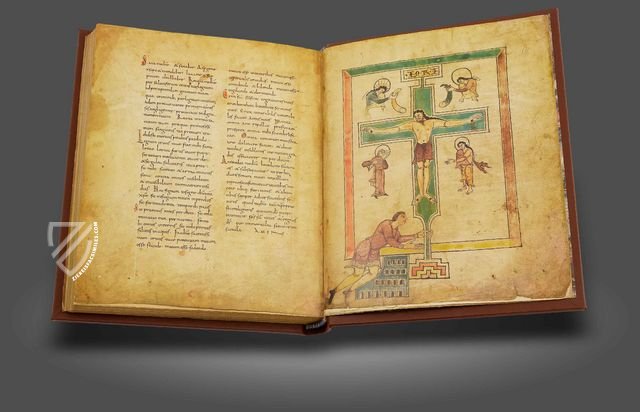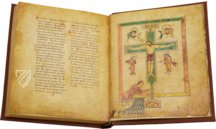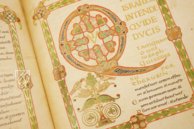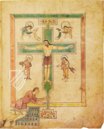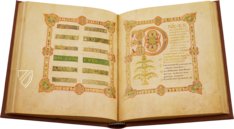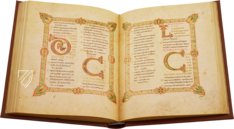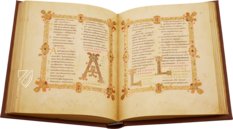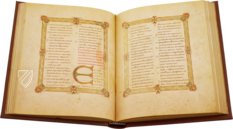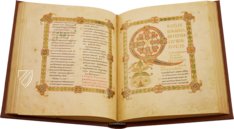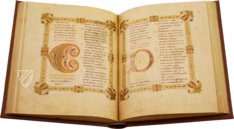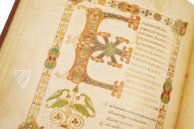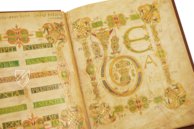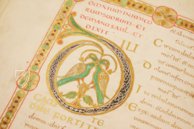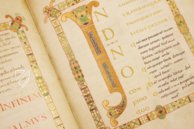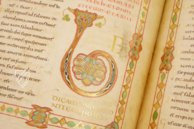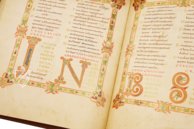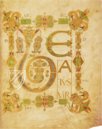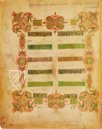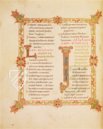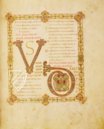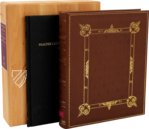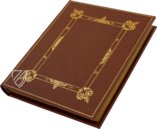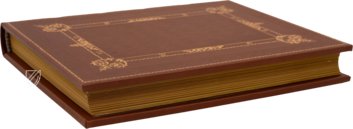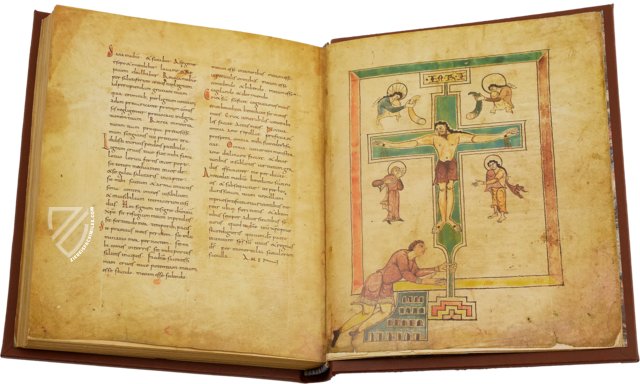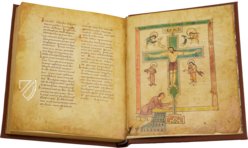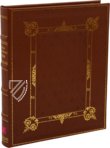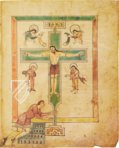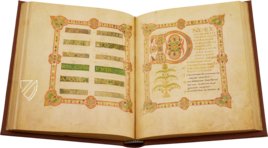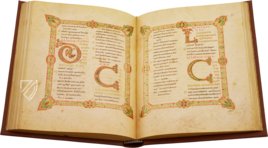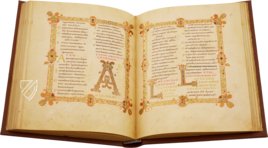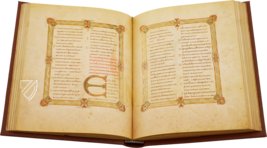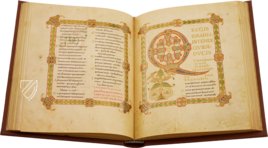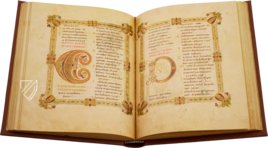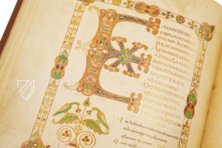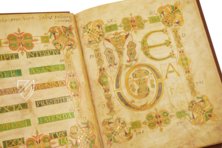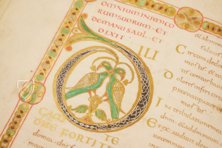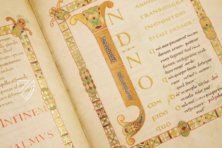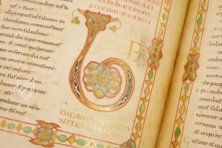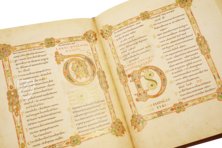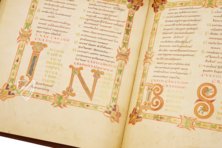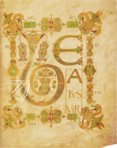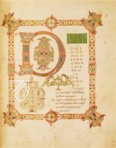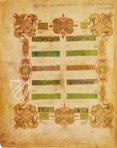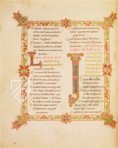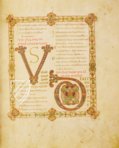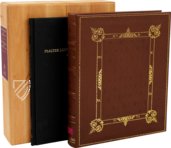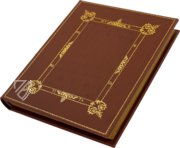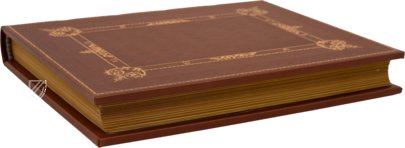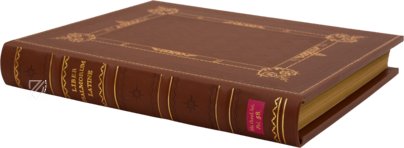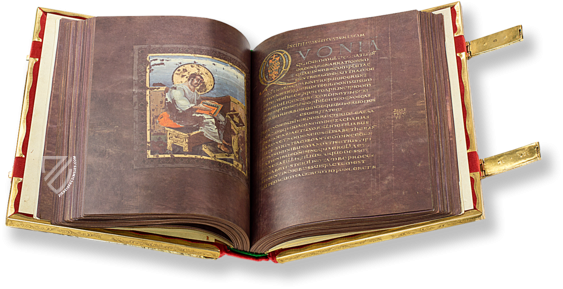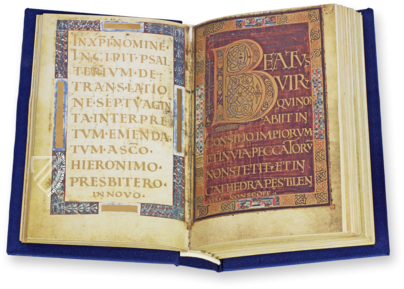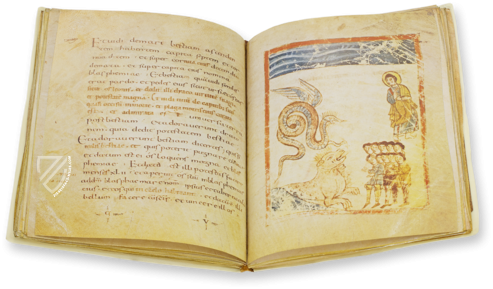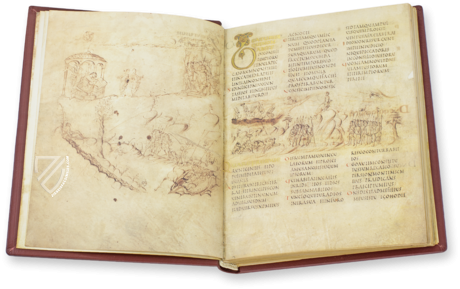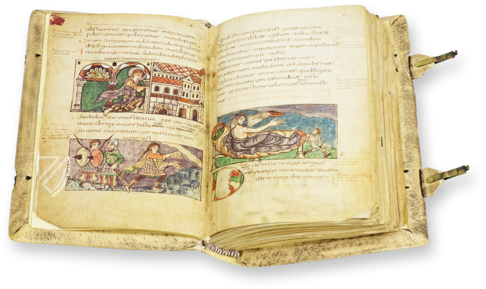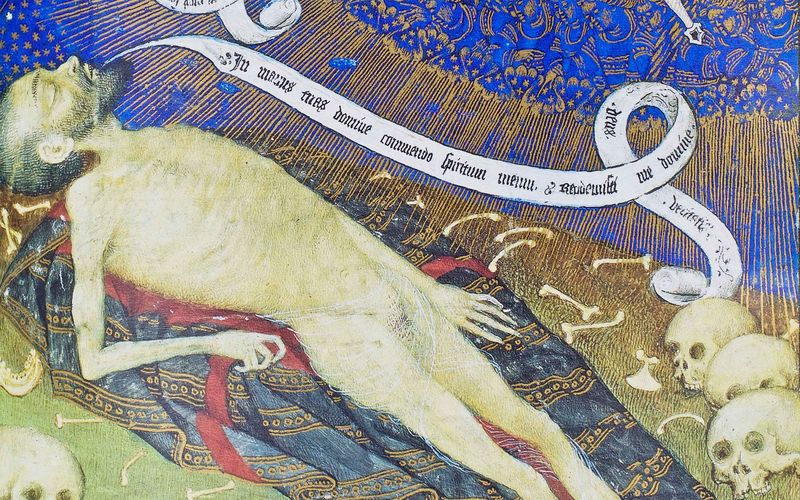Psalter of Louis the German
(3,000€ - 7,000€)
Created in the mid-9th century, the Palter of Louis the German is a magnificent specimen of Franco-Saxon art, which was an artistic movement in northern France that blended Insular illumination from the British Isles with the Carolingian style native to France. It was commissioned by Louis the German (810–876), a grandson of Charlemagne who ruled as the first king of the East Francia after the breakup of the great Carolingian Empire from 843 until his death. The texts of the psalms are surrounded by stunning Insular-style frames made of intricate interlace and fantastical animal figures, especially birds. Despite the rich illumination, the manuscript is focused on the text. The only figural representation is the famous Crucifixion scene with donor figure, reflecting the unique and fascinating character of the codex as a whole.
Psalter of Louis the German
Before the emergence of the book of hours, Psalters were the most popular manuscripts created for personal use. In addition to the Psalms, they often contained common prayers and excerpts from the Gospels that were connected to the songs of David in one way or another. Some of the most magnificent examples of early medieval Psalters were commissioned by or for members of the Carolingian dynasty, including the specimen at hand: the Psalter of Louis the German. It was created in the mid-9th century for the grandson of Charlemagne who ruled as the first king of East Francia after the division of the Carolingian Empire from 843 to 876. It is embellished with some of the finest examples of Carolingian/Insular illumination created with a wonderful color palette and gold leaf, including a gorgeous miniature of the Crucifixion that is unique among Carolingian manuscripts.
A Perfect Specimen of Franco-Saxon Art
At the behest of King Louis the German (810-876), the manuscript was created in the scriptorium of the Abbey of St. Bertin in Saint Omer, not far from Calais on the French coast of the English Channel. The adornment of the codex is characterized by an exemplary blend of the Hiberno-Saxon artistic tradition with Frankish illumination. 200 intricate interlace frames in gold leaf, and numerous decorative initials created with gorgeous shades of green, reddish brown, and purple. Various elements from Insular illumination, such as birds and other animals, can be found alongside the Carolingian miniscule, which was written down by a masterful scribe. Despite the rich ornamentation, the manuscript is text-focused and the only figural depiction in it is limited to the Crucifixion scene. This Franco-Saxon style is unique and distinguished from the Carolingian illumination, which was itself already influenced by the Irish and Anglo-Saxon monks who came to serve Charlemagne in Aachen and continued to serve his descendants in the generations to follow, in addition to serving as missionaries in Central Europe.
For Which Louis?
An inscription in the manuscript indicates that it was dedicated to LUDOVICUS REX, or “King Louis”, and could have been commissioned either by Louis I “the Pious” or his son Louis II “the German”. It is only through the careful examination of various artistic details that researchers have been able to determine who the patron of the manuscript was, but this ambiguity may have been intentional – an indication of continuity whereby Louis the German traced his legitimacy back to Charlemagne, his grandfather. Elaborately illuminated Psalters were traditionally commissioned by members of the Carolingian dynasty, including the Golden Psalter of Charlemagne, commissioned as a gift for his wife Hildegard and one of the oldest manuscripts created for personal use.
Kneeling Before the Crucifixion
The only figural representation in the manuscript consists of a miniature showing a young man kneeling at the base of the cross upon which Christ was crucified. Dressed in a purple tunic, this person is most likely meant to represent the king himself. Christ, flanked by the Virgin Mary and Saint John the Evangelist as well as figures representing the Sun and Moon, looks down upon him with a look of approval. Unlike most Carolingian donor portraits, which show the patron seated on a throne and being presented with the manuscript they commissioned, this miniature shows a mighty Frankish monarch as a beardless youth paying homage to the King of Kings.
Codicology
- Alternative Titles
- Psalter Ludwigs des Deutschen
Psalter for King Louis the German
Psautier de Louis le Germanique
Ludwigspsalter
Psalter van Lodewijk de Duitser - Size / Format
- 240 pages / 29.4 × 24.6 cm
- Origin
- France
- Date
- Second quarter of the 9th Century
- Epochs
- Style
- Genre
- Language
- Script
- Carolingian Minuscule Insular Uncial
- Illustrations
- 1 full-page crucifixion with donor portrait, 162 decorated and gilded initials and 115 interlaced and gilded frames
- Content
- Old Testament Psalm Texts, hymns, litanies and a prayer of the Holy Cross
- Patron
- Louis II, known as Louis the German
- Artist / School
- Franco-Saxon school
- Previous Owners
- Clergymen in Vreden and Rellinghausen
Psalter of Louis the German
“D” Initial
An unusual color palette of black, green, and reddish-brown contrasts wonderfully with the gold leaf that has been generously applied to this masterful “D” initial. Aside from the intricate interlace patterns, also known as Celtic knots, the influence of Insular illumination is evident in the incorporation of zoomorphic figures – birds in this instance. Every page of Carolingian miniscule text in this rare Franco-Saxon manuscript is richly embellished with Insular-style initials and frames.

Psalter of Louis the German
Kneeling Before Christ Crucified
In contrast to a typical donor portrait from the Carolingian period, in which the patron of the manuscript is shown enthroned and receiving the manuscript, here Louis the German presents himself as a beardless youth kneeling at the foot of the cross. Aside from the fact that he is dressed in royal purple, this miniature is an expression of piety and humility before the King of Kings.
Blood flows from the hands and feet of Christ as he looks down upon the King of East Francia with a look of approval on his bearded face. He is flanked by the Virgin Mary and Saint John the Evangelist as well as two figures representing the Sun and Moon – an allusion to the eclipse or portent that occurred at the moment of Jesus’ death according the Gospels.
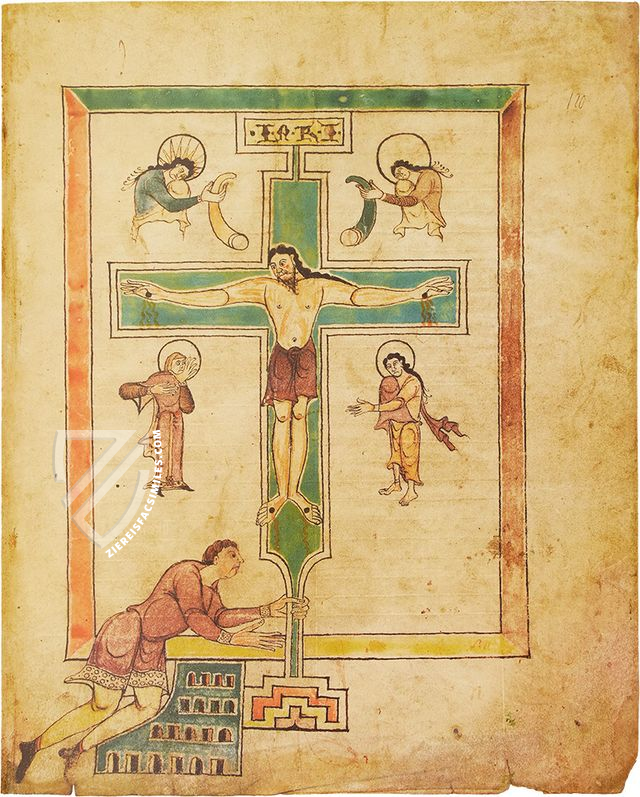
#1 Psalter Ludwigs des Deutschen
Language: German
(3,000€ - 7,000€)
- Treatises / Secular Books
- Apocalypses / Beatus
- Astronomy / Astrology
- Bestiaries
- Bibles / Gospels
- Chronicles / History / Law
- Geography / Maps
- Saints' Lives
- Islam / Oriental
- Judaism / Hebrew
- Single Leaf Collections
- Leonardo da Vinci
- Literature / Poetry
- Liturgical Manuscripts
- Medicine / Botany / Alchemy
- Music
- Mythology / Prophecies
- Psalters
- Other Religious Books
- Games / Hunting
- Private Devotion Books
- Other Genres
- Afghanistan
- Armenia
- Austria
- Belgium
- Belize
- Bosnia and Herzegovina
- China
- Colombia
- Costa Rica
- Croatia
- Cyprus
- Czech Republic
- Denmark
- Egypt
- El Salvador
- Ethiopia
- France
- Germany
- Greece
- Guatemala
- Honduras
- Hungary
- India
- Iran
- Iraq
- Israel
- Italy
- Japan
- Jordan
- Kazakhstan
- Kyrgyzstan
- Lebanon
- Liechtenstein
- Luxembourg
- Mexico
- Morocco
- Netherlands
- Palestine
- Panama
- Peru
- Poland
- Portugal
- Romania
- Russia
- Serbia
- Spain
- Sri Lanka
- Sweden
- Switzerland
- Syria
- Tajikistan
- Turkey
- Turkmenistan
- Ukraine
- United Kingdom
- United States
- Uzbekistan
- Vatican City
- A. Oosthoek, van Holkema & Warendorf
- Aboca Museum
- Ajuntament de Valencia
- Akademie Verlag
- Akademische Druck- u. Verlagsanstalt (ADEVA)
- Aldo Ausilio Editore - Bottega d’Erasmo
- Alecto Historical Editions
- Alkuin Verlag
- Almqvist & Wiksell
- Amilcare Pizzi
- Andreas & Andreas Verlagsbuchhandlung
- Archa 90
- Archiv Verlag
- Archivi Edizioni
- Arnold Verlag
- ARS
- Ars Magna
- ArtCodex
- AyN Ediciones
- Azimuth Editions
- Badenia Verlag
- Bärenreiter-Verlag
- Belser Verlag
- Belser Verlag / WK Wertkontor
- Benziger Verlag
- Bernardinum Wydawnictwo
- BiblioGemma
- Biblioteca Apostolica Vaticana (Vaticanstadt, Vaticanstadt)
- Bibliotheca Palatina Faksimile Verlag
- Bibliotheca Rara
- Boydell & Brewer
- Bramante Edizioni
- Bredius Genootschap
- Brepols Publishers
- British Library
- C. Weckesser
- Caixa Catalunya
- Canesi
- CAPSA, Ars Scriptoria
- Caratzas Brothers, Publishers
- Carus Verlag
- Casamassima Libri
- Centrum Cartographie Verlag GmbH
- Chavane Verlag
- Christian Brandstätter Verlag
- Circulo Cientifico
- Club Bibliófilo Versol
- Club du Livre
- CM Editores
- Collegium Graphicum
- Collezione Apocrifa Da Vinci
- Comissão Nacional para as Comemorações dos Descobrimentos Portugueses
- Coron Verlag
- Corvina
- CTHS
- D. S. Brewer
- Damon
- De Agostini/UTET
- De Nederlandsche Boekhandel
- De Schutter
- Deuschle & Stemmle
- Deutscher Verlag für Kunstwissenschaft
- DIAMM
- Droz
- E. Schreiber Graphische Kunstanstalten
- Ediciones Boreal
- Ediciones Grial
- Ediclube
- Edições Inapa
- Edilan
- Editalia
- Edition Deuschle
- Edition Georg Popp
- Edition Leipzig
- Edition Libri Illustri
- Editiones Reales Sitios S. L.
- Éditions de l'Oiseau Lyre
- Editions Medicina Rara
- Editorial Casariego
- Editorial Mintzoa
- Editrice Antenore
- Editrice Velar
- Edizioni Edison
- Egeria, S.L.
- Eikon Editores
- Electa
- Emery Walker Limited
- Enciclopèdia Catalana
- Eos-Verlag
- Ephesus Publishing
- Ernst Battenberg
- Eugrammia Press
- Extraordinary Editions
- Fackelverlag
- Facsimila Art & Edition
- Facsimile Editions Ltd.
- Facsimilia Art & Edition Ebert KG
- Faksimile Verlag
- Feuermann Verlag
- Folger Shakespeare Library
- Franco Cosimo Panini Editore
- Friedrich Wittig Verlag
- Fundación Hullera Vasco-Leonesa
- G. Braziller
- Gabriele Mazzotta Editore
- Gebr. Mann Verlag
- Gesellschaft für graphische Industrie
- Getty Research Institute
- Giovanni Domenico de Rossi
- Giunti Editore
- Graffiti
- Grafica European Center of Fine Arts
- Guido Pressler
- Guillermo Blazquez
- Gustav Kiepenheuer
- H. N. Abrams
- Harrassowitz
- Harvard University Press
- Helikon
- Hendrickson Publishers
- Henning Oppermann
- Herder Verlag
- Hes & De Graaf Publishers
- Hoepli
- Holbein-Verlag
- Houghton Library
- Hugo Schmidt Verlag
- Idion Verlag
- Il Bulino, edizioni d'arte
- ILte
- Imago
- Insel Verlag
- Insel-Verlag Anton Kippenberger
- Instituto de Estudios Altoaragoneses
- Instituto Nacional de Antropología e Historia
- Introligatornia Budnik Jerzy
- Istituto dell'Enciclopedia Italiana - Treccani
- Istituto Ellenico di Studi Bizantini e Postbizantini
- Istituto Geografico De Agostini
- Istituto Poligrafico e Zecca dello Stato
- Italarte Art Establishments
- Jan Thorbecke Verlag
- Johnson Reprint Corporation
- Josef Stocker
- Josef Stocker-Schmid
- Jugoslavija
- Karl W. Hiersemann
- Kasper Straube
- Kaydeda Ediciones
- Kindler Verlag / Coron Verlag
- Kodansha International Ltd.
- Konrad Kölbl Verlag
- Kurt Wolff Verlag
- La Liberia dello Stato
- La Linea Editrice
- La Meta Editore
- Lambert Schneider
- Landeskreditbank Baden-Württemberg
- Leo S. Olschki
- Les Incunables
- Liber Artis
- Library of Congress
- Libreria Musicale Italiana
- Lichtdruck
- Lito Immagine Editore
- Lumen Artis
- Lund Humphries
- M. Moleiro Editor
- Maison des Sciences de l'homme et de la société de Poitiers
- Manuscriptum
- Martinus Nijhoff
- Maruzen-Yushodo Co. Ltd.
- MASA
- Massada Publishers
- McGraw-Hill
- Metropolitan Museum of Art
- Militos
- Millennium Liber
- Müller & Schindler
- Nahar - Stavit
- Nahar and Steimatzky
- National Library of Wales
- Neri Pozza
- Nova Charta
- Oceanum Verlag
- Odeon
- Orbis Mediaevalis
- Orbis Pictus
- Österreichische Staatsdruckerei
- Oxford University Press
- Pageant Books
- Parzellers Buchverlag
- Patrimonio Ediciones
- Pattloch Verlag
- PIAF
- Pieper Verlag
- Plon-Nourrit et cie
- Poligrafiche Bolis
- Presses Universitaires de Strasbourg
- Prestel Verlag
- Princeton University Press
- Prisma Verlag
- Priuli & Verlucca, editori
- Pro Sport Verlag
- Propyläen Verlag
- Pytheas Books
- Quaternio Verlag Luzern
- Reales Sitios
- Recht-Verlag
- Reichert Verlag
- Reichsdruckerei
- Reprint Verlag
- Riehn & Reusch
- Roberto Vattori Editore
- Rosenkilde and Bagger
- Roxburghe Club
- Salerno Editrice
- Saltellus Press
- Sandoz
- Sarajevo Svjetlost
- Schöck ArtPrint Kft.
- Schulsinger Brothers
- Scolar Press
- Scrinium
- Scripta Maneant
- Scriptorium
- Shazar
- Siloé, arte y bibliofilia
- SISMEL - Edizioni del Galluzzo
- Sociedad Mexicana de Antropología
- Société des Bibliophiles & Iconophiles de Belgique
- Soncin Publishing
- Sorli Ediciones
- Stainer and Bell
- Studer
- Styria Verlag
- Sumptibus Pragopress
- Szegedi Tudomànyegyetem
- Taberna Libraria
- Tarshish Books
- Taschen
- Tempus Libri
- Testimonio Compañía Editorial
- Thames and Hudson
- The Clear Vue Publishing Partnership Limited
- The Facsimile Codex
- The Folio Society
- The Marquess of Normanby
- The Richard III and Yorkist History Trust
- Tip.Le.Co
- TouchArt
- TREC Publishing House
- TRI Publishing Co.
- Trident Editore
- Tuliba Collection
- Typis Regiae Officinae Polygraphicae
- Union Verlag Berlin
- Universidad de Granada
- University of California Press
- University of Chicago Press
- Urs Graf
- Vallecchi
- Van Wijnen
- VCH, Acta Humaniora
- VDI Verlag
- VEB Deutscher Verlag für Musik
- Verlag Anton Pustet / Andreas Verlag
- Verlag Bibliophile Drucke Josef Stocker
- Verlag der Münchner Drucke
- Verlag für Regionalgeschichte
- Verlag Styria
- Vicent Garcia Editores
- W. Turnowski Ltd.
- W. Turnowsky
- Waanders Printers
- Wiener Mechitharisten-Congregation (Wien, Österreich)
- Wissenschaftliche Buchgesellschaft
- Wissenschaftliche Verlagsgesellschaft
- Wydawnictwo Dolnoslaskie
- Xuntanza Editorial
- Zakład Narodowy
- Zollikofer AG

